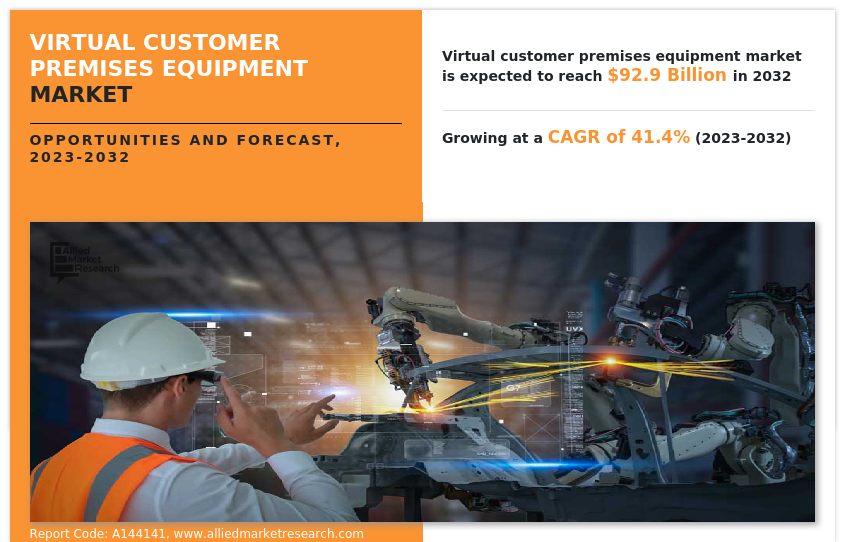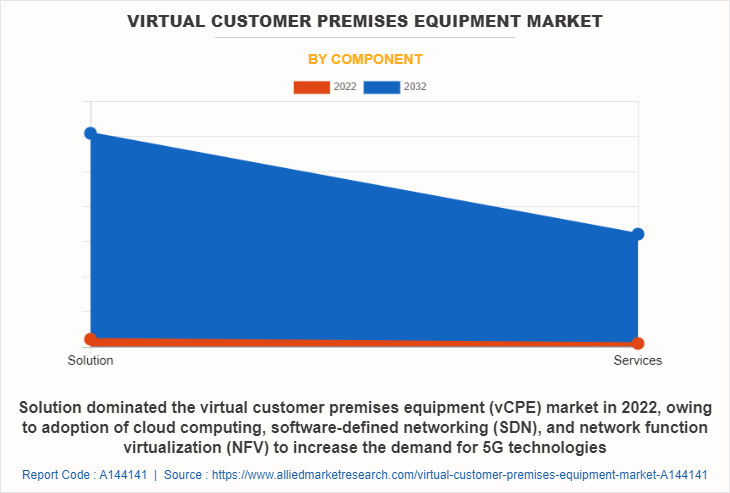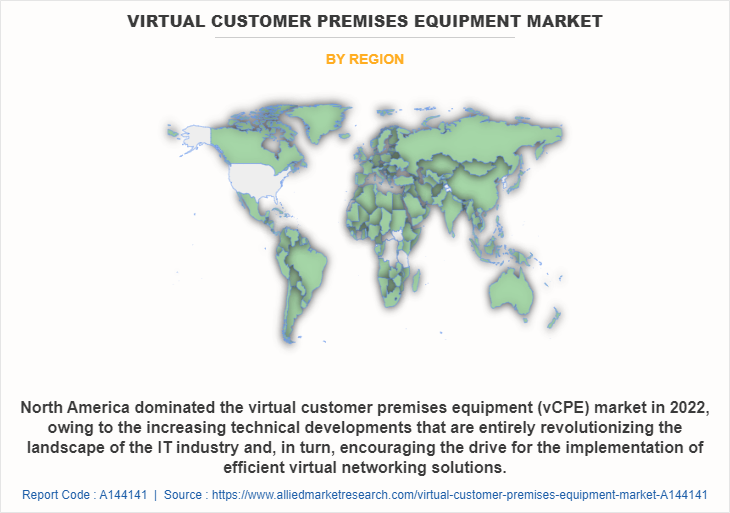Virtual Customer Premises Equipment Market Overview
The global virtual customer premises equipment market was valued at USD 3 billion in 2022, and is projected to reach USD 92.9 billion by 2032, growing at a CAGR of 41.4% from 2023 to 2032.
The adoption of network virtualization in business, the reduction of reliance on hardware, and the quick development of 5G networks primarily drive the growth of the market. However, network virtualization security issues hamper market growth to some extent. Moreover, the demand for scalable and adaptive network solutions is likely to increase, creating attractive opportunities for market expansion during the forecast period.

The vCPE market, which offers flexibility, cost savings, and streamlined management, consists of software-based solutions that virtualize conventional customer premises equipment services. In the upcoming years, the vCPE industry is anticipated to experience considerable development and adoption as SDN and NFV technologies continue to develop. Furthermore, the supply of value-added services is made possible by vCPE, which helps to improve network security and performance. The vCPE market, which offers flexibility, cost savings, and streamlined management, consists of software-based solutions that virtualize conventional customer premises equipment services.
The virtual customer premise equipment (vCPE) market refers to the market for software-based networking solutions that enable the virtualization of traditional customer premise equipment (CPE) functions. CPE stands for customer premises equipment, which includes hardware-based devices including routers, switches, firewalls, and other networking equipment deployed at the client's site. These hardware-based CPE functions are virtualized and run as software applications on COTS hardware or in a cloud environment in the vCPE market.
Since actual hardware is not required on the customer's premises owing to virtualization, management is easier, expenses are lower, and flexibility and scalability are increased. Service providers or businesses remotely deploy and centrally administer a variety of networking functions and services with vCPE solutions. These capabilities include load balancing, routing, switching, network security, and WAN optimization. vCPE enables dynamic provisioning, quick service deployment, and simpler management & maintenance by virtualizing these functions.
Segment Overview
The virtual customer premises equipment market is segmented on the basis of component, deployment mode, enterprise size, end user, and region. On the basis of component, it is bifurcated into solution and services. On the basis of deployment mode, it is segregated into on-premise and cloud. On the basis of enterprise size, it is fragmented into large enterprise and small and medium-sized enterprise. On the basis of end user, it is categorized into data center and telecom service providers and enterprise. On the basis of enterprises, it is categorized into BFSI, IT, government and public sector, manufacturing, healthcare and others. On the basis of region, it is analyzed across North America, Europe, Asia-Pacific, and LAMEA.

On the basis of component, the global virtual customer premises equipment market share was dominated by the solution segment in 2022 and is expected to maintain its dominance in the upcoming years, owing to the demand for robust virtual capabilities, ease of use, compatibility with different platforms, and integration with existing infrastructure. However, the service segment is expected to witness the highest growth, owing to the increasing adoption of virtual services in several organizations to provide convenience, expertise, and all-time support, allowing organizations to focus on their core business functions.

By region, North America dominated the market share in 2022 for the virtual customer premises equipment market size. The region has a strong foothold of numerous large enterprises, government agencies, and organizations with a huge focus on virtual premises. However, Asia-Pacific is expected to exhibit the highest growth during the forecast period. The region is experiencing a rapid digital transformation across various industries, including healthcare, finance, government, and telecommunications, which is expected to provide lucrative growth opportunities for the market in this region.
Key Market Players
The global virtual customer premises equipment industry is dominated by key players such as International Business Machines Corporation, Arista Networks, Inc., Broadcom Inc., Cisco Systems Inc., Hewlett Packard Enterprise Development Lp, Juniper Networks, Inc., Dell Inc., NEC Corporation, Intel Corporation, Huawei Technologies Co., Ltd. These players have adopted various strategies to increase their market penetration and strengthen their position in the virtual customer premises equipment industry.
Top Impacting Factors
Adoption of Network Virtualization in Business
The virtual customer premise equipment (vCPE) market has expanded as a result of organizations implementing network virtualization. Network virtualization involves separating network services and processes from specialized hardware and virtualizing them instead. This enables companies to create and maintain networks more effectively. The increase in use of network virtualization in enterprises is influenced by a number of variables. Organizations need to be able to adjust their network resources swiftly to shift in demands in the fast-paced commercial climate of today. Businesses abstract and virtualize network functions such as firewalls, switching, and routing to provide more adaptable and scalable network services. Without being constrained by physical hardware, this agility enables businesses to develop new services and apps, respond quickly to change in customer needs, and dynamically assign resources.
Moreover, businesses need network infrastructure that accommodate the dynamic nature of cloud environments as they progressively move their applications and data to the cloud. The foundation for creating cloud-native networks is network virtualization, which enables companies to develop virtual networks that are independent of physical infrastructure. By achieving increased flexibility, scalability, and cost-efficiency in their network infrastructure, enterprises better align with the cloud computing paradigm. In addition, by ensuring uniform security rules and configurations across the network, virtualizing network functions improves overall security posture and complies with industry laws.
In conclusion, the market for virtual customer premise equipment (vCPE) has expanded as a result of companies using network virtualization. The increase in popularity of network virtualization is influenced by a number of factors, including the requirement for agility, flexibility, cloud compatibility, alignment with SDN & NFV, cost savings, and improved network security & compliance. Businesses improve their network infrastructure's agility, scalability, cost-efficiency, and security by adopting network virtualization, which drives demand for vCPE solutions that allow the virtualization of customer premises equipment.
Reduction of Reliance on Hardware
Customer premise equipment (CPE) was historically referred to as the actual hardware installed at a customer's site to deliver network services. However, the development of virtualization technologies has made it possible for companies to rely less on specialized hardware, which has various benefits that fuel demand for vCPE solutions. The cost-effectiveness of reducing hardware dependency is a major reason. Traditional CPE systems include hefty up-front hardware investments as well as ongoing maintenance and upgrade expenses. Businesses do away with the necessity for specialized hardware at client sites by implementing vCPE. Alternatives include virtualizing network services and hosting them in a centralized data center or cloud environment. As a result of the decreased hardware needs, organizations reduce their capital investment costs by avoiding the need to purchase pricey physical devices for each customer location.
In addition, enterprises obtain better flexibility and scalability in their network architecture because to the reduction of hardware dependence. When using conventional hardware-based CPE, expanding network services or introducing new services frequently necessitates the installation of extra physical hardware at client locations. This procedure is expensive and time-consuming. The ability to virtualize network activities and services, in contrast, enables enterprises to scale resources and provide new services without being constrained by physical hardware.
In conclusion, the virtual customer premise equipment (vCPE) market is driven by the desire to reduce reliance on hardware. The surge in popularity of vCPE solutions is due to their affordability, adaptability, scalability, simplified management, alignment with cloud computing, and increased security brought on by reducing hardware dependence. By utilizing virtualization technology, companies lessen their dependency on specialized hardware, which results in financial savings, improved operational effectiveness, increased security, and enhanced network infrastructure agility.
Key Benefits for Stakeholders
This report provides a quantitative analysis of the market segments, current trends, estimations, and dynamics of the market analysis from 2022 to 2032 to identify the prevailing virtual customer premises equipment market forecast.
The market research is offered along with information related to key drivers, restraints, and opportunities.
Porter's five forces analysis highlights the potency of buyers and suppliers to enable stakeholders make profit-oriented business decisions and strengthen their supplier-buyer network.
In-depth analysis of the market segmentation assists to determine the prevailing market opportunities.
Major countries in each region are mapped according to their revenue contribution to the global virtual customer premises equipment market growth.
Market player positioning facilitates benchmarking and provides a clear understanding of the present position of the market players.
The report includes the analysis of the regional as well as global market trends, key players, market segments, application areas, and market growth strategies.
Virtual Customer Premises Equipment Market Report Highlights
| Aspects | Details |
| Market Size By 2032 | USD 92.9 billion |
| Growth Rate | CAGR of 41.4% |
| Forecast period | 2022 - 2032 |
| Report Pages | 411 |
| By Deployment Mode |
|
| By Enterprise Size |
|
| By End User |
|
| By Component |
|
| By Region |
|
| Key Market Players | Juniper Networks, Inc., International Business Machines Corporation, Dell Inc., Intel Corporation, Hewlett Packard Enterprise Development LP, NEC Corporation , Broadcom Inc., Arista Networks, Inc., Cisco Systems Inc., Huawei Technologies Co., Ltd. |
Analyst Review
Rise in need for software-defined networking (SDN) and network functions virtualization (NFV) technologies, the virtual customer premise equipment (vCPE) market has expanded and is more widely used. The term "vCPE" describes the virtualization of conventional customer premise equipment (CPE) operations, including firewalls, switches, and routers, into software programs that run on commercially available hardware or in a cloud setting. The advantages it provides, such as cost savings, flexibility, scalability, and streamlined network management, are what drive the virtual customer premise equipment (vCPE) market growth. Organizations are more effectively able to adapt to the change in business needs by dynamically provisioning and deploying services by virtualizing CPE functionalities. vCPE solutions are primarily being adopted by the telecommunications, managed service providers, businesses, and cloud service providers. These sectors gain from the capacity to remotely deploy and maintain networking features and services, which enhances business productivity and customer satisfaction. As SDN and NFV technologies advance, the industry is anticipated to experience significant expansion in the next few years. The adoption of vCPE is being fueled by the surge in need for scalable and flexible networking solutions as well as by the desire to reduce costs. The complexity of implementation and issues with data security and privacy, however, could limit the market's expansion. Firm data security measures, adherence to data protection laws, and thorough implementation support are all necessary for organizations to handle these issues. To summarize, the vCPE industry offers substantial opportunity for businesses to virtualize the functions of their customer premise equipment, providing cost savings, agility, and easier management. Organizations from a variety of industries are anticipated to embrace vCPE solutions as the market continues to develop to improve their network infrastructure and provide value-added services.
The global virtual customer premises equipment market was valued at USD 3 billion in 2022, and is projected to reach USD 92.9 billion by 2032
The global virtual customer premises equipment market is projected to grow at a compound annual growth rate of 41.4% from 2023 to 2032 to reach USD 92.9 billion by 2032
The global virtual customer premises equipment (vCPE) industry is dominated by key players such as International Business Machines Corporation, Arista Networks, Inc., Broadcom Inc., Cisco Systems Inc., Hewlett Packard Enterprise Development Lp, Juniper Networks, Inc., Dell Inc., NEC Corporation, Intel Corporation, Huawei Technologies Co., Ltd. These players have adopted various strategies to increase their market penetration and strengthen their position in the virtual customer premises equipment (vCPE) industry.
North America is the largest regional market for Virtual Customer Premises Equipment
The adoption of network virtualization in business, the reduction of reliance on hardware, and the quick development of 5G networks primarily drive the growth of the market
Loading Table Of Content...
Loading Research Methodology...



